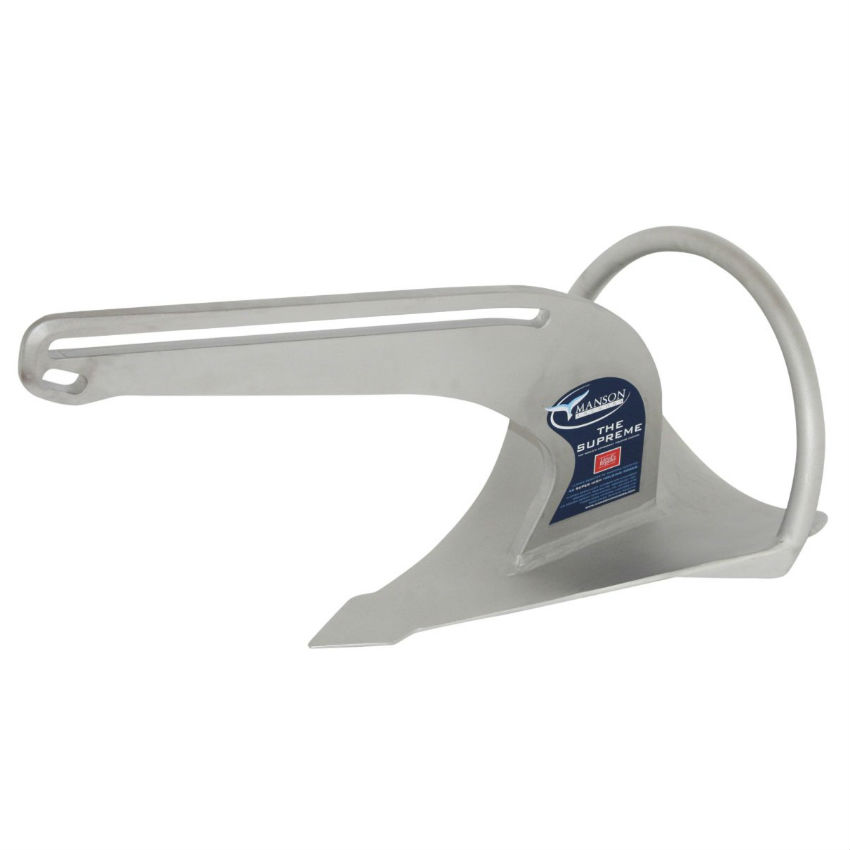
Choosing the right type of anchor for a boat is arguably one of the least understood parts of seamanship. Most people think, “How difficult can it be to choose an anchor for my boat? After all, it just holds the boat in place, right?” They couldn’t be more wrong. Anyone who has spent time boating knows that proper boat anchoring requires the right equipment, local seabed knowledge, and careful selection, all of which can lead to confusion when trying to make a decision.
If you choose the wrong anchor, there is a solid chance that your boat will drift into maritime channels, collide with other boats, or drift ashore while you sleep. While some anchors can be expensive, instead of taking the risk it’s a far better idea to invest in the right anchor for your boat right away.
How to Choose
It is easy to be confused when looking just at all the different types, but the easiest way to choose an anchor is to combine the type of seabed you will primarily be anchoring in, your boat size/weight and stowage. The primary factor should be the seabed as an anchor that stows well but doesn’t hold the seabed is useless for anything other than a private artificial reef or paperweight.
Types and Categories of Anchors
There are several different types of anchors available to choose from and most boating specialists will recommend you choose two varieties to ensure anchorage for your boat should one not hold in a particular seabed, to reduce swing in a crowded harbor or in adverse weather conditions to hold down the boat and keep it put. Generally, as wind speed doubles the force on the boat increases by four ―two anchors will be required to stabilize the boat.
Fluke / Danforth / Lightweight Anchor
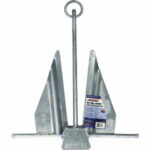 The most popular type of anchor is the fluke anchor. This anchor is also referred to as the Lightweight or the Danforth. The fluke anchor is lightweight, and easy to stow. It holds small boats well in mud and sand and it is the most common anchor used on small boats. They tend to be some of the cheapest anchors, so this may also contribute to their popularity with recreational boaters.
The most popular type of anchor is the fluke anchor. This anchor is also referred to as the Lightweight or the Danforth. The fluke anchor is lightweight, and easy to stow. It holds small boats well in mud and sand and it is the most common anchor used on small boats. They tend to be some of the cheapest anchors, so this may also contribute to their popularity with recreational boaters.
Not all fluke style anchors are created equal though. The angle of the flukes to the shaft and size of the flukes (both width and length) vary and should be considered depending on the seabed. For example, wider flukes and larger shaft angle can perform better in mud bottoms than longer flukes with a smaller angle as this allows for more suction to be created by the mud and less chance of the anchor pulling out.
>> Click Here to see Fluke / Danforth Anchors
Plow / CQR / Wing / Delta
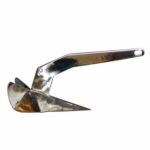 These anchor style are mostly variations of an older plow style of anchor. They offer good weed penetrating capabilities due to the sharp entry point and holding power in various conditions.
These anchor style are mostly variations of an older plow style of anchor. They offer good weed penetrating capabilities due to the sharp entry point and holding power in various conditions.
In general, these anchors reset themselves quite well in wind or rapid tide conditions. These anchors are also preferred in grass, mud, and sand bottoms. However, these anchors are very big and stowing them is quite difficult for smaller boats so these anchors are preferred on larger boats due to the stability they offer.
While some, such as the CQR are still quite popular they have been shown to not hold as well as others such as the Delta so care should be used if selecting from this style of anchor to ensure you are selecting the best performing option.
>> Click Here to see Plow / CQR / Delta Anchors
Claw / Bruce Anchor
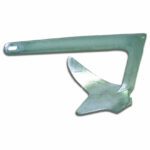 The claw or Bruce anchor is a popular anchor due to its holding ability in varied seabed conditions but generally requires a larger anchor than a claw or plow style for the same application. One of its weaknesses is holding in a weedy seabed, which tends to allow the anchor to slide rather than penetrate the surface.
The claw or Bruce anchor is a popular anchor due to its holding ability in varied seabed conditions but generally requires a larger anchor than a claw or plow style for the same application. One of its weaknesses is holding in a weedy seabed, which tends to allow the anchor to slide rather than penetrate the surface.
Due to their reduced holding power compared to other anchors, the claw definitely requires proper size selection along with the right amount of chain or will lead to frustration when the anchor doesn’t hold.
With the proper setup for a claw anchor, it will hold well, reset itself quickly should it become loose during swings from tidal changes and allow for use in many seabed conditions.
>> Click Here to see Claw / Bruce Anchors
Grapnel Anchor
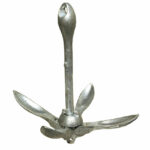 Grapnel anchors are a good choice for small boats that don’t require a lot of holding power in situations where the bottom is rocky and gives the points something to hook onto. Unfortunately, the hooking function can sometimes make grapnel anchors incredibly difficult to retrieve.
Grapnel anchors are a good choice for small boats that don’t require a lot of holding power in situations where the bottom is rocky and gives the points something to hook onto. Unfortunately, the hooking function can sometimes make grapnel anchors incredibly difficult to retrieve.
Some grapnel style anchors such as the one pictured here are folding which can be a big benefit on small craft, not only to minimize the storage space required, but to remove the hazard of stepping or falling onto one of the sharp points.
>> Click Here to see Grapnel Anchors
Mushroom Anchor
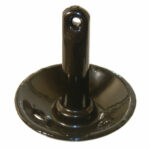 The mushroom anchor works primarily based on weight and suction and is not very popular in recreational boating, although has been used by some on very small and light craft such as jon boats and kayaks in an environment where current and wind are not major factors although a grapnel style anchor would be a better choice.
The mushroom anchor works primarily based on weight and suction and is not very popular in recreational boating, although has been used by some on very small and light craft such as jon boats and kayaks in an environment where current and wind are not major factors although a grapnel style anchor would be a better choice.
Mushroom anchors are also very popular in holding buoys or in mooring situations where over time the seabed can build up over the anchor and drastically increase the holding power.
But for recreational boating, who has the time to wait this long for their anchor to set? Skip this style unless you have a very specific application you know it will work for.
>> Click Here to see Mushroom Anchors
Kedge / Navy Anchor
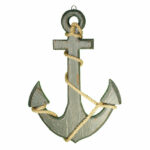 When you hear the word “anchor” isn’t the picture of the Kedge / Navy anchor what you first imagine? Whether that is due to seeing it on the side of old ships in movies or cartoons still remains a mystery to modern man.
When you hear the word “anchor” isn’t the picture of the Kedge / Navy anchor what you first imagine? Whether that is due to seeing it on the side of old ships in movies or cartoons still remains a mystery to modern man.
While this style is still used in large ships, it is of nearly no use for the common recreational boater for anything other than decorative purposes (which is why if you look close, you’ll see our chosen image is a wooden decorative one) on a boat house or tiki hut wall.
>> Click Here to see Kedge / Navy Anchors
Scoop / Rocna / Supreme Anchor
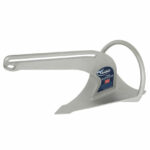 The Rocna or Supreme anchor is a modified scoop or plow style anchor, generally with a roll bar that helps to facilitate the anchor rolling over to reset itself should it become loose.
The Rocna or Supreme anchor is a modified scoop or plow style anchor, generally with a roll bar that helps to facilitate the anchor rolling over to reset itself should it become loose.
In multiple tests, the Rocna or Supreme style anchors were the best all-around performers in varied seabed conditions and these style of anchors tend to be popular with cruisers due to the various seabed conditions they may encounter while on their travels.
>> Click Here to see Scoop / Rocna / Supreme Anchors
Sea Anchor / Drift Anchor / Drift Sock
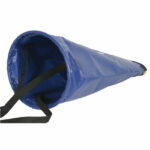 What about sea anchors? You may have heard or seen the term “sea anchor” and might be wondering what one is.
What about sea anchors? You may have heard or seen the term “sea anchor” and might be wondering what one is.
A sea anchor is not an anchor at all but rather a “sock” or funnel that is primarily used to slow down your drift in relation to the current or stabilize your boat at drift in rough conditions.
As far as holding your boat at rest, it is useless and should not be considered.
>> Click Here to see Sea / Drift Anchors & Drift Socks
Boat Size & Anchor Weight
When the anchor is dropped, it penetrates the surface of the seabed and creates suction. The weight of the anchor and the suction creates holding power that prevents boat movement. Holding power of modern anchors can vary between 10 times to 200 times the anchor’s weight depending on the style of anchor and seabed conditions.
Anchor weight is an important factor that should not be ignored. Boat manufacturers may recommend a weight range and anchor size for your boat and anchor manufacturers may recommend a length and / or displacement rating for their anchors.
Make sure you stick to the values recommended to ensure holding.
Bottom Conditions
Anchors need to create adequate resistance in the sea bottom. As a result, they have to impact and penetrate the sea bottom or snag protrusions on the sea bottom. Before choosing an anchor, you have to consider sea bottom conditions and then make a choice.
Here are some general rules of thumb:
Sand bottom: Fluke anchors and non-hinged scoop or plow anchors are a good choice
Mud bottom: Broader shank fluke anchors help create additional suction.
Rock or coral bottom: High-strength plow or grapnel anchors hold better here.
Clay bottom: Sharp entry point plow or scoop anchors.
Grassy bottom: Sharp entry point plow anchors.
Special anchors may be required for special situations or if a particular type of anchor doesn’t hold in your primary seabed type. If in doubt, ask those who are experienced in the area. Online boating forums can be of particular help if you are planning a trip to a location you are unfamiliar with.
Anchor Materials
Most anchors are made from galvanized steel, lightweight magnesium/aluminum combinations or Grade 316 stainless steel. Most boat owners choose galvanized steel as it is affordable, corrosion-resistant, and lightweight but you can choose any variety you want depending on your boating needs and budget.
Anchor Rode: Chain or Line
The anchor shackle connects the anchor to the rode or chain. You can attach the anchor to the boat with a rope, chain, or a combination of both.
Rope lines are commonly used and they can be made from nylon, polyester, or other synthetic materials. However, nylon rope is strong, lightweight, and easy to use. It is also incredibly elastic and affordable. Some materials will degrade over time in the sun due to UV exposure so be sure to choose a material that is durable for your environment.
Chains are also commonly used and they have the advantage of being abrasion resistant and environmentally stable. If your boat is in coral-infested areas, chains are a far better option than ropes this is because coral is sharp and can cut the rope. If the chain is long enough, it also adds to the weight of the anchor and ensures better stability. You can choose from BBB, high-test, stainless steel, and proof coil for your anchor chains.
Each version has its own advantages and disadvantages. For example, steel-proof coil is the most affordable and the easiest to use. BBB chains have shorter links but the entire chain is heavier and difficult to handle. High-test is not as strong as BBB and proof coil but it is lighter and easier to handle. Some boaters like stainless-steel as it is corrosion-resistant but it can be expensive. You can find corrosion-resistant or vinyl-coated chains available as well.
Combining Chains & Rope
Most boaters now use a combination of chains and ropes to manage the anchor weight. Combination rodes are used since they combine the strengths of both ropes and chains.
A shorter length of chain is combined with a long length of three-strand nylon to prevent abrasion. You may have to choose a long scope (7:1) to compensate for the low weight of the rode. Spliced rodes are also available as they are long lasting and stable. You can buy readymade spliced rodes but some boaters prefer to make their own. This process produces a sleek rode that is easy to handle, lightweight, and abrasion-resistant.
How much chain?
Rules of thumb vary depending who you ask but generally are from 1/2 to a full boat length of chain and depends on your usage. For example, a 20ft boat could have anywhere from 10-20 feet of chain. More is always better, but in some scenarios you may not need as much. If, for example you were to only boat in calm condition, not be subject to much wind or current and not anchoring overnight then you may be fine with 10 ft of chain.
Size of chain also plays a factor – thicker or heavier chain will require less than a smaller diameter chain. Each situation will be different so consider yours carefully and err on the side of caution.
Now that you know how to choose anchors, make sure you choose the best anchor possible according to your budget. Cheap anchors are available but they are often made from low-quality castings and have suspect hinge designs. They may not be able to withstand pressure and tides and you could end up in some serious trouble at sea. Invest in the best and you’ll have one less thing to worry about on the water.

Leave a Reply